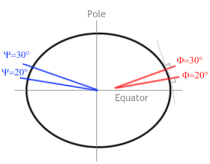Nautical Units Converter
This calculator converts various nautical measurement units. It includes conversions for speed and distance units. For speed, it can convert knots to miles per hour, kilometers per hour, feet per second or meters per second. For distance, it can convert nautical miles to miles, kilometers, cables, leagues, meters or feet.
Nautical mile
The nautical mile corresponds approximately to one minute of arc of latitude along any meridian. The First International Extraordinary Hydrographic Conference, Monaco (1929) defined the international nautical mile as exactly 1852 meters. The Soviet Union accepted this definition in 1931, the United States in 1959, and United Kingdom in 1970.
The international nautical mile consists of 10 cables (1 cable=185.2 meters ).
Sea mile

The sea mile is the distance of one minute of latitude arc at a given latitude and along the current meridian. Because the Earth being an oblate (lens-like) spheroid, the length of a nautical mile is longest at the poles and shortest at the equator; see the article Ellipsoid for more details on oblate ellipsoids.
At first glance, it may seem contrary - one-minute arc length must be longer at the equator because the equatorial Earth radius is longer than the polar one. It's true for geocentric latitude (), but the geographic latitude (
) is not geocentric. It's the angle between the equatorial plane and a line that is normal to the reference ellipsoid. See the picture.
The following calculator approximates the sea mile length at a given geographic latitude:
Knot
A knot is a unit of speed widely used in navigation. A vessel traveling at 1 knot along a meridian travels one minute of geographic latitude in one hour (or one sea mile per hour). The name of the unit knot, for nautical mile per hour, was derived from the speed measurement method using chip log. A chip log consists of a wooden board attached to a line. The log-line has several knots tied in it at uniform spacings (47 feet and 3 inches or 14.4 meters). When the navigator wished to determine his vessel's speed, a sailor dropped the chip log over the stern of the ship. The log-line was allowed to run out for a fixed period of time. The ship's speed was indicated by the number of knots on the line, passed through in 28 seconds.
Currently, the international knot is defined as 1.852 km/h (one nautical mile per hour).
Comments